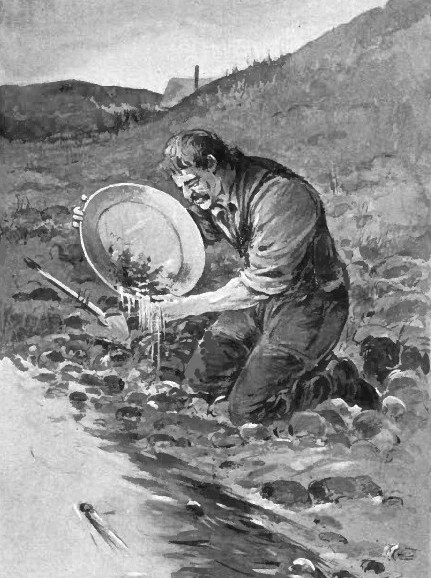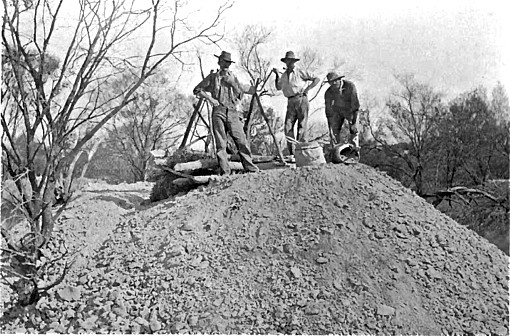One of the first things for a prospector for gold and silver to acquaint himself with, is the elements of geology. He can read this up theoretically in many excellent treatises and manuals, such as LeConte, Dana, and Shalers' Manuals, and Geikies' Hand-Book of Field Geology, etc., and become learned in the names of eras and epochs, and the jargon of scientific names of fossils and minerals, and varieties of rocks; but let him not imagine at the end of this process that he "knows geology." Geology can no more be learned by means of a book without field work and the actual personal contact with nature and rocks, than chemistry or assaying can be acquired without ever using a test tube or a cupel. The student may, perhaps, be unfavorably situated for this practical field work. There may be no mountains or upheavals of strata, or deep natural ravines within available distance to study. He is located, perhaps, on the great, monotonous, flat prairie. Very well, then let him study what lies nearest him. This same flat, monotonous prairie has an interesting and wonderful history. Let him read up what he can find about this in his books, then go out and examine what he can of the few feet of horizontal strata exposed in some shallow water-course or dry ravine; examine minutely, both with eyes and microscope, the minerals composing these strata. Let him classify and collect and note the different kinds of pebbles scattered over the surface, or in the bed of a brook. Let him speculate as to the cause of the undulations of the surface, the deposition and peculiar character of the clays forming the soil. Let him study thoroughly the geology of his native village, his immediate surroundings, first.
The knowledge and practical habit of observation so acquired, will lead later to more extensive studies in wider fields. A student may be shut up in a big city; let him study the paving stones of the streets and visit the stone yards of the masons. It will pay him better to take a trip to some distant mountain region, than to buy another expensive book on geology after he has mastered the first bare elements. Nothing like field work, eye practice, and hammer practice. The student should endeavor, whenever he possibly can, to verify by actual vision and personal experience whatever he reads in his books. When traveling, let him always carry a geological hammer with him, and at any station the train may stop for a few moments, step out and try to get a specimen of the country rock ; at the same time let him study all he can of the geology of the country he is passing through from the windows of the train, aided perhaps by a geological map. The genuine prospector is always looking about him, is everlastingly cracking stones, has always his eye wide open for "something kind o' curious."
If he is near some mountain region, where, as in Colorado, the whole strata of the earth's crust is upheaved and exposed, along the mountain flanks, in the depths of the canyons, or on the summits of the peaks, after studying his manual, let the student get, if he can, some published geological report on such a country, such as those of the U. S. Geological Survey, abounding in illustrations and geological sections. Let him take this book in hand and go to the very place described and pictured as a geological section, and with his hammer study each member of the section closely. This will make him familiar with the different geological periods, formations, rocks, minerals and fossils, as they actually appear in nature rather than as his imagination has supposed them to be from his study of the text books: book geology and field geology are not always in perfect harmony.
Having studied and learned one local section well, such as that cut by a stream along the foothills of a mountain range, let him repeat the course at the other and more distant points. He will find at each locality, though the main features are the same, there is always an interesting variety, such as new fossils, peculiar minerals, changes of dip, faults, or other structural peculiarities. Along the flanks of a mountain range, a prospective prospector cannot study too many of these geological sections. Having become familiar with these foothill sections, he is prepared to plunge into the heart of the range itself. At first, and for long distances perhaps, he will encounter only granitic rocks forming the axis and core of the range. These are well worthy of study and full of variety. Later the canyon may open into some mountain valley or park, where the strata he studied on the foothills or prairie border are again repeated and he finds himself again at home. Seizing upon some well defined and familiar representative of a geological horizon, from this as a standpoint, he soon reads off the succession of the rest.
Here, however, the appearance and texture of the rocks will probably be different to what they were in the foothills. Heat has so changed or metamorphosed the sandstones and shales, that they are scarcely recognizable as the same rocks as those of the foothills. Yet even here a highly silicified fossil shell, or a leaf impression on shales, or sandstones changed into slates or quartzite, will give the prospector his clue and his desired and definite geological horizon, and he will have little difficulty in again arranging and grouping correctly the rocky series. But a prospector has a "practical end" in view. He is "after the precious metal, "gold and silver, not after "pure science" or "fossils or such"; what practical use in there, he may ask, in this same careful study of geological sections, where probably there is not a speck of gold or silver?
Simply that minerals and metals of economic value, such as gold and silver are more frequently found in the rocks of certain geological periods than in others. Locally this is especially true. For instance, nearly all the silver-lead deposits of Colorado are found in a certain bed of limestone not over 200 feet thick, to be found only in one geological period out of many others, viz.: the lower division of the Carboniferous. It would naturally then be advisable for a Colorado prospector to be able surely to identify this limestone, as well as the geological horizon in which it occurs, among the various other limestones of various other periods and ages in the mountains. Again, gold is mainly confined to crystalline rocks of Archaean age or to porphyries associated with these. A prospector should be familiar with these rocks and their varieties. Gold is also found in the placers derived largely from the breaking up of these rocks; the ability to distinguish the different pebbles may lead to the source whence the gold was derived. Familiarity with rocks of all kinds is a necessary prospector's education in itself.
SURFACE SIGNS:
The prospector in hunting on the surface outcrop for signs of such
contact or blanket or pocket deposits must look out for signs of
decomposition along the line of contact, such as lead carbonates, carbonate
of copper, oxide of iron, together with crystalline matter such as
fluorspar, gypsum, or
barite. He may also observe in the vertical joints leading down from
the surface into the body of the limestone, rusty clay fillings and iron
stains. In these "blanket," bedded deposits, prospects on a large scale may
sometimes advantageously be done by drilling with diamond drills from the
surface down through as many of the strata as are suspected of being ore
bearing, the "cores" brought up will show if an ore body has been penetrated
together with its approximate thickness at a certain point, and if this
process is continued over a certain area, the approximate areal limit of the
ore body may be ascertained. This work may follow upon a close examination
first of mineral signs along the outcrop. It is sometimes done after an area
has been exploited for some time by actual mining with a view of discovering
new bodies or continuations of the ore.
Whilst profound fault cracks may be filled by lava, those not descending to such great depths doubtless lay open, till they were gradually filled by solutions carrying in earthy vein-stone and metallic matter ; in a word they were the channels of mineral or hot springs. It must not be supposed that these fault cracks were ever "open chasms" commensurate in width with the wide dykes and veins now found in them, but rather in some cases very close fitting cracks, mere lines of weakness, the walls pressed closely together by prodigious lateral pressure. In other cases, the fissure would be rather a shattered zone passing down through the strata, than one definite line of fissure. Doubtless when the molten lava ascended through these fissures it greatly widened them to admit of its volume. In the case of true fissure veins, the fissure or shattered zone was enlarged by the corroding, substituting power of acid mineral solutions till we have to-day a fissure vein twenty to fifty or more feet in width. In the shattered zone, this substituting process would go on easily and rapidly, until nearly all the shattered fragments were replaced by mineral matter except a few "indigestible" pieces, which if small, would cause what is called a brecciated vein, and if large, "horses" in a vein. These fragments are not so much pieces that have fallen from above into an open fissure gradually filling up with solutions of quartz and vein matter in which they became entangled, but rather undigested, unsubstituted fragments of the wall rock, immediately adjacent to the fragments, for at times some line in the fragment corresponds to a line in the adjacent wall rock without evidence of any serious displacement. Again, the shadowy outlines of fragments can be observed partially but not entirely replaced by quartz or vein matter. Sometimes the "breccias" are surrounded by rings of quartz or metal and called "cockade ores."
In some places in this
region the quartz, by reason of its superior hardness, stands up above the
softer lava like a low, rusty, or white wall. Again, at other localities
instead of being a bold outcrop, the vein is represented by a sharp, shallow
depression forming a narrow little ravine or trench, the path of a rivulet
and zone of abundant vegetation. In this case the vein was full of
decomposable minerals, such as
pyrite whose oxidation decomposition products were washed
out. leaving a depression in the rocks. So, amongst some of the indications
of a fissure vein to the prospector we may note :
1st. Brown or green stains on rocks.
2d. A bold quartz vein like a wall above the country.
3d. A narrow ravine or gulch.
4th. The path of a rivulet and exuberant growth of vegetation.
Continue on to:
Minerals For The Prospector, Part I
Return To:
Gold And Silver Basic Prospecting Methods


